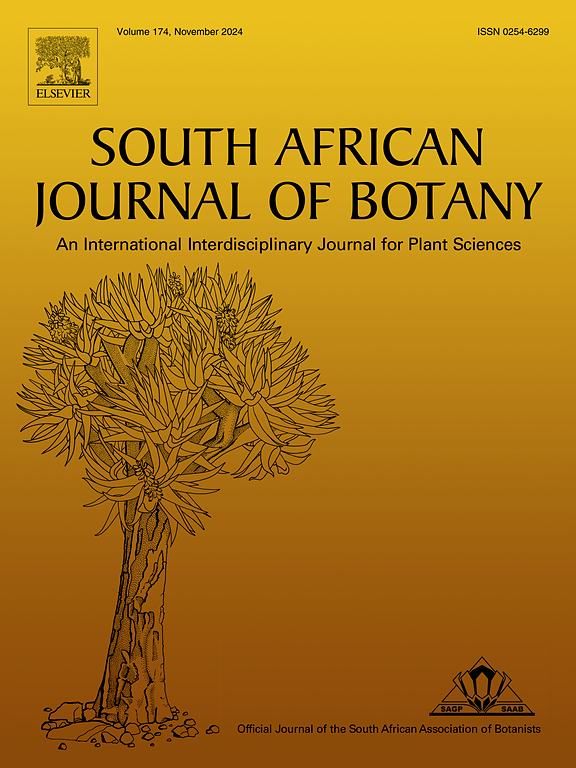桉树精油对玉米象(Motschulsky, 1855)和棘皮虫(Say, 1831)的化学成分和杀虫潜力
IF 2.7
3区 生物学
Q2 PLANT SCIENCES
引用次数: 0
摘要
鞘翅目害虫是东非收获后粮食损失的主要原因之一。研究了生长在乌干达阿鲁阿和卡巴罗勒地区的两种桉树(E. camuldulensis和E. grandis)鲜叶精油对豆象(Acanthoscelides obtectus)和玉米象(Sitophilus zeamais)的植物化学成分和生物杀虫潜力。用50µL/mL的EO处理阿鲁阿3岁大的camuldulensis,对玉米螟的生物杀虫效果最好,24 h后死亡率为100%;用20µL/mL的Kabarole 5岁大的e- EO处理对obtectus的生物杀虫效果最好,死亡率为100%。气相色谱/质谱分析表明,环芬烯(6.61 ~ 51.69%)、三氟乙酰基-α-松油醇(2.75 ~ 54.58%)和3-己酮(9.85 ~ 35.98%)是所有精油的主要成分。3年生阿鲁阿山茱萸的EO对玉米螟具有较高的杀虫活性,其原因可能是其3-己酮(35.98%)、1-羟基-1-甲基-2-氧辛烷(19.21%)和桉油醇(9.96%)含量较高。另一方面,5年生大叶青叶精油对粗纹伊蚊的最高杀虫活性可能与其成分2-冰片醇(1.41%)和2,6-二甲基-1,3,5,7-八辛四烯,E,E-(1.05%)有关。我们的研究结果表明,利用桉树物种的生态系统是一种有希望的综合管理储存害虫的替代方案。从3年生的camuldulensis和5年生的E. grandis叶子中提取的油可以作为一种替代的基于自然的解决方案,分别用于对抗储存食品中的玉米和豆象鼻虫。本文章由计算机程序翻译,如有差异,请以英文原文为准。
Chemical composition and insecticidal potential of Eucalyptus essential oils against Sitophilus zeamais (Motschulsky, 1855) and Acanthoscelides obtectus (Say, 1831)
Coleopteran pest infestation is among the top causes of postharvest grain losses in East Africa. This study investigated the phytochemical composition and bioinsecticidal potential of essential oils (EOs) from fresh leaves of two Eucalyptus species (E. camuldulensis and E. grandis) grown in Arua and Kabarole Districts of Uganda on bean weevils (Acanthoscelides obtectus) and maize weevils (Sitophilus zeamais). Treatment with EO of the three-year-old E. camuldulensis from Arua showed the best insecticidal activity at 50 µL/mL against S. zeamais with 100 % mortality after 24 h. The best bioinsecticidal effect against A. obtectus (100 % mortality) was observed with EO of five-year-old E. grandis from Kabarole at 20 µL/mL. Gas chromatography/mass spectrometry analysis showed that cyclofenchene (6.61–51.69 %), trifluoroacetyl-α-terpineol (2.75–54.58 %) and 3-hexanone (9.85–35.98 %) were the major components in all the EOs. The high insecticidal activity of the EO of three-year-old E. camuldulensis from Arua against S. zeamais could be due to its high 3-hexanone (35.98 %), 1-hydroxy-1-methyl-2-oxoindane (19.21 %) and eucalyptol (9.96 %) contents. On the other hand, the highest insecticidal activity of EO of the five-year-old E. grandis leaves from Kabarole against A. obtectus may be associated with its components: 2-Bornanol (1.41 %) and 2,6-Dimethyl-1,3,5,7-octatetraene, E,E- (1.05 %). Our results suggest that the use of EOs from the Eucalyptus species is a promising alternative for integrated management of the storage pests. Oils from the three-year old E. camuldulensis and five-year-old E. grandis leaves could be adopted as an alternative nature-based solution for combating maize and bean weevils, respectively in stored food products.
求助全文
通过发布文献求助,成功后即可免费获取论文全文。
去求助
来源期刊

South African Journal of Botany
生物-植物科学
CiteScore
5.20
自引率
9.70%
发文量
709
审稿时长
61 days
期刊介绍:
The South African Journal of Botany publishes original papers that deal with the classification, biodiversity, morphology, physiology, molecular biology, ecology, biotechnology, ethnobotany and other botanically related aspects of species that are of importance to southern Africa. Manuscripts dealing with significant new findings on other species of the world and general botanical principles will also be considered and are encouraged.
 求助内容:
求助内容: 应助结果提醒方式:
应助结果提醒方式:


